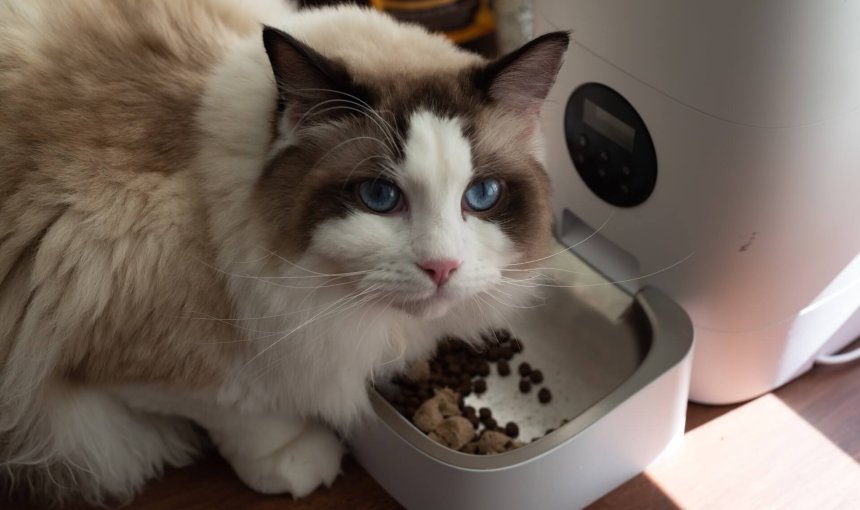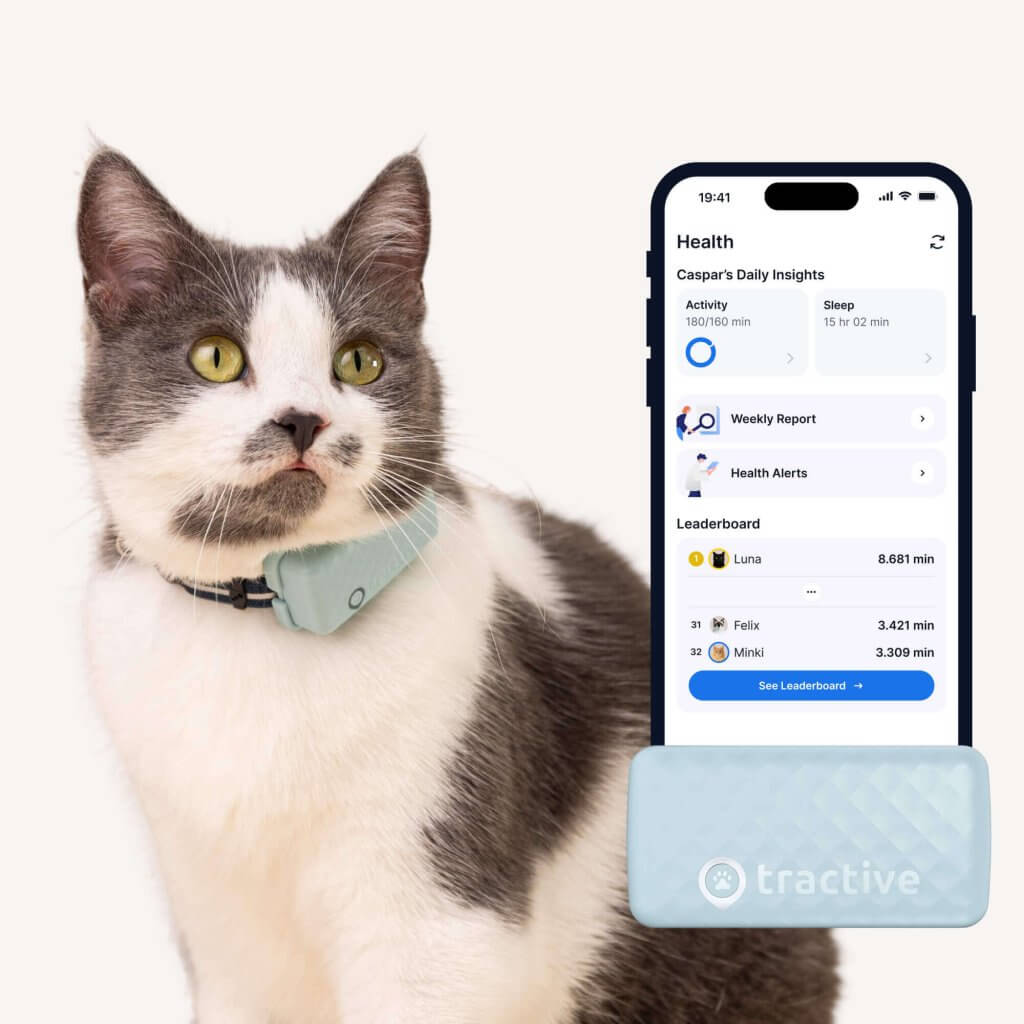Cat Food Allergies: What To Watch Out For
Around 10-15% of your cat's allergies might occur due to the food they eat. So here are some of the most common cat food allergies to watch out for - from all the major food groups.

If you’ve noticed your cat sneezing or scratching more than often around mealtime, we’ve got you covered. In this post, we’re going to cover some of the most common cat food allergies to watch out for. Let’s dive right in so you can prep your cat’s next meal, sniffle-free.

Find out where your cat spends their time.
Read more- Cat food allergies : What they are & how they show up
- Summarized: The most common cat food allergies
- The main symptoms of cat food allergies
- What to expect during a vet check-up
- How an elimination diet can help with cat food allergies
- Can cats eat dog food?
- Stay on top of your cat’s nutrition – allergies & all
Cat food allergies: What they are & how they show up
Your cat’s food allergies begin when their immune system reacts adversely to certain proteins found in their food. These reactions can cause symptoms ranging from mild to severe – and can affect your cat’s overall health and comfort.
Cats can develop food allergies at any time after three months of age. Both male and female cats are equally likely to develop food allergies. They might even develop allergies against ingredients they’ve been eating for a long time. It’s not entirely clear why cats develop food allergies – only that they might. However, your cat’s genetic predisposition might play a role.
The main symptoms of cat food allergies are excessive itching, skin infections, gastrointestinal, and respiratory problems. Oftentimes, these symptoms might occur in combination with environmental allergens like pollen or mildew, or pests like fleas and ticks. If you’re suspecting your cat might be experiencing similar such symptoms, make sure to check in with your local vet.
Summarized: The most common cat food allergies
Like other allergies, your cat’s food allergies can’t be cured – only managed. This is usually by avoiding specific ingredients that might trigger a flareup, or finding a specific diet that better fits your cat’s needs. Here’s a quick summary of the different ingredients your cat might be sensitive to:
| Product | Food types |
| Protein | Chicken, beef, lamb, fish, turkey, raw eggs, raw meat and bones |
| Dairy | Milk, cheese, milk derivatives |
| Grain | Cat food that contains wheat gluten |
| Vegetarian sources | Cornmeal, corn gluten, onion, garlic, grapes, raisins |
| Additives | Rendered fat, BHA, BHT, PG |
The main symptoms of cat food allergies
Excessive itching
Food allergies might lead your cat to experience an itchy face, belly, ears, groin, legs, and paws. As a result, they might lick (or groom) themselves more than normal to deal with the itchiness. In some cases, cats might even experience itching around their rectums – so they might “scoot”, or drag themselves around the floor on their butts to relieve it.
Skin infections
As a result of itching and over-grooming, your cat might actually injure or irritate their skin, leading to lesions. This might show up as redness, sores, and hair loss.
Ear infections
Food allergies might also manifest as recurring infections of cats’ skin and ears. You might see them engaging in head shaking or scratching at their ears. In other cases, you might also see pus or a dark discharge from your cat’s ears.
Gastrointestinal problems
While less common, some cats might experience vomiting and diarrhea as a result of a food allergy. They might also have more frequent bowel movements and might strain while doing so. These might also occur as a result of a bacterial infection from contaminated food.
Respiratory problems
In some cases, your cat might experience coughing, sneezing, or wheezing when exposed to food allergens. If you’ve ruled out the season as a cause, make sure to double-check the ingredients they’re consuming.
Behavioral changes
Because of the discomfort caused by their allergy, your cat might seem more lethargic, irritable, or might show a change in appetite. Be especially careful if they’ve been avoiding meals altogether for a few days, since it might indicate a more serious health condition.
Similarly, cats who are sick might hide or avoid you altogether – since they’re trying to manage their symptoms by themselves. It’s always a concerning sign if your formerly active, sociable cat is now avoiding company or sleeping more than usual.
But if you’re able to track your cat’s behaviors – like their sleep and activity – you can identify a dip or a spike early on. (And drop by your vet, if necessary.) By catching on to these changes in time, you can help prevent your cat’s health from worsening.

Get health alerts for your cat
Our cats can’t always tell us if something’s wrong. But if their tracker detects unusual changes in their routine, you’ll get an alert, helping you catch potential issues early.
What to expect during a vet check-up
At your visit, your vet might ask you about your cat’s medical history, diet, and symptoms to determine what might have triggered their allergy. They might also run a couple of tests to get a full picture of your cat’s health. Which might include:
Physical tests
Your vet will start by closely examining your cat’s skin, ears, coat, and other affected areas. (Also to rule out a flea infection.)
A blood test
A blood test helps your vet identify whether your cat’s immune system is producing antibodies to combat the allergy. If your cat has a bad case of atopic dermatitis from excessive scratching, they might conduct a radioallergosorbent (RAST) test to determine which allergens are triggering your cat’s skin infections.
Skin tests
Here, your vet might inject a small amount of allergen under your cat’s skin to observe their reaction. (Like, for example, extracts with animal proteins.) This can help them identify what type of ingredient might be causing the food allergy.
Your vet might then look out for signs of a localized allergic response on your cat’s skin – like hives, inflammation, or redness. This can help them immediately identify which allergen might be the culprit.
Prescription medications
Besides these tests, your vet might also prescribe you:
- Corticosteroids or antihistamines to control itching.
- Antibiotics or other medications for any infections.
- Medicated shampoos for relieving itchiness.
How an elimination diet can help with cat food allergies
The most accurate and reliable method to determine whether your cat is experiencing a food allergy is with an 8-12 week elimination diet trial.
What is an elimination diet?
An elimination diet means changing your cat’s diet to include less of the triggering food source. At times, you might need to get rid of it immediately. Or you could opt for hypoallergenic or limited-ingredient diets.
Limited-ingredient diets refer to foods specially designed to contain novel (or new) protein sources that your cat might not have eaten yet. Which means they’ll be less likely to develop an allergic reaction to it.
How can I get started with an elimination diet for my cat?
Here are a couple of steps to get you started on a new allergy-friendly diet for your cat:
- Opt for simple, home-cooked meals, ideally including only one source of protein and one source of fiber.
- Pay extra attention to food labels and make sure you avoid those with added flavors and preservatives.
- Switch to a hypoallergenic diet. For example, Royal Canin rabbit, duck, or venison or Blue Buffalo NP are both vet-approved novel proteins prescribed as part of a hypoallergenic meal plan for cats.8
- Consider a hydrolyzed diet. This means feeding your cat foods that break down proteins into smaller components, which makes them easier to digest.
If your cat’s symptoms improve, you can slowly reintroduce their old diet and check if their symptoms return. If they do return, it’s better to continue with your vet-recommended diet. (And eliminate their old diet immediately.) Following this, introduce individual ingredients every 2 weeks and check your cat’s symptoms. If none occur, your cat isn’t allergic to this ingredient. But if symptoms do occur over the next 2 weeks, your cat is allergic to this ingredient and you should avoid it in future meals.
Staying realistic with your cat’s elimination diet
Elimination diets can be a process of trial and error – and you might only see results around 10-12 weeks in. You’ll also have to avoid giving your cat any extra treats or table scraps during this time (no matter how much they try and convince you otherwise.) Also, once you’ve figured out a diet that fits your cat’s needs, you’ll need to stick to it for the long term.
Changing your cat’s diet also might not completely cure their food allergy. Rather, it can only help you manage it better. You’ll have to be extra careful to avoid exposing you cat to these ingredients for good.
However, an elimination diet is the safest, most reliable way to figure out what food items your cat might be allergic to. Plus, if you’re consistent and careful with your cat’s diet, their prognosis for food allergies is generally good.
Can cats eat dog food?
In general, yes – cats can occasionally eat dog food in limited amounts. But remember: cats aren’t dogs, so they have different nutritional needs.
- Cats are primarily carnivores. This means that their diet should ideally contain meat-based proteins and animal fats to keep them healthy. They might occasionally nibble on your grass or houseplants to supplement their diet, but it’s the exception rather than the norm.
- Dogs are omnivores. This means they can safely eat both meat and vegetables as part of a balanced diet. Here are a couple of vegetables that are safe to eat for dogs.
Because of this, feeding your cat dog food on the regular can be detrimental to your cat’s health in the long run. They’ll primarily suffer from nutritional deficiencies – especially taurine, which you find added to cat foods, but not in dog foods. Over time, these nutritional deficiencies can lead to your cat experiencing cardiovascular problems and digestive issues.
Stay on top of your cat’s nutrition – allergies & all
Managing your cat’s food allergies isn’t easy – but we hope you feel more reassured knowing what signs and symptoms to look out for. And with regular activity and sleep tracking, you can immediately catch on changes in your cat’s behavior – and help them get the care they need.



